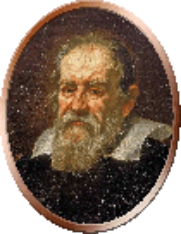The work of Copernicus influenced other astronomers of the late sixteenth century. Galileo, for
example, came to believe in and promote the heliocentric theory. In 1609, after having heard of an
interesting little device using two lenses that made distant objects appear closer, he constructed his own instrument,
made entirely by himself and turned that device to the heavens. With this little telescope, he proved that it was the Earth
which moved around the Sun; not the other way around.
Even more boldly, he published his findings for all to read, not in Latin, the obscure language of scholars, but in everyday
italian! These observations directly refuted the old theories of Aristotle. Among his most revealing observations was the
discovery of the phases of the planet Venus. ANd, of course, Galileo was the first to recognize that Jupiter itself has four moons orbiting around
it. These four moons form a constantly changing pattern around the giant planet.
This was to get Galileo into serious trouble with the Pope and the Holy Office, resulting in his trial before the Inquisition and his eventual
‘confession’..
This song is for you, Galileo.
There was one man, roughly contemporary to Galileo, who would not believe that the Earth was in motion. That was the somewhat
eccentric Tycho Brahe.




















